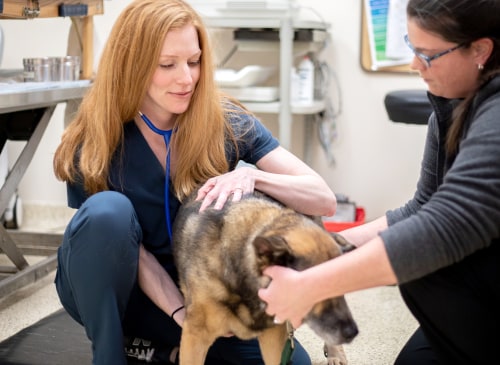The Duty of Ultrasound and CT Scan in Modern Veterinary Practices: Insights From Experienced Professionals
In modern vet techniques, ultrasound and CT scans significantly boost diagnostic capabilities. These imaging techniques offer essential insights right into animal health and wellness, leading therapy choices. Experienced specialists recognize the one-of-a-kind benefits of each method. Ultrasound uses real-time assessments, while CT scans provide intricate anatomical details. Understanding their applications and functions increases vital inquiries about their influence on patient outcomes and the future of veterinary diagnostics. What insights can be obtained from their integrated use?
Understanding Ultrasound in Veterinary Medication
Ultrasound is an essential diagnostic tool in veterinary medicine, offering a non-invasive method to envision inner frameworks. This imaging strategy uses high-frequency sound waves to develop real-time pictures of cells and body organs, allowing vets to evaluate problems without medical treatment. Common applications include reviewing the heart, liver, kidneys, and reproductive body organs, in addition to monitoring pregnancies.The treatment is reasonably fast and can be done in various setups, making it an easily accessible option for vets. Unlike radiography, ultrasound offers detailed info regarding soft cells and blood circulation, which is vital for precise diagnoses.Veterinary experts count on ultrasound to detect irregularities such as tumors, cysts, and fluid build-up. Its capability to direct biopsies and other treatments better improves its utility in professional method. By offering a secure and effective way to check out inner composition, ultrasound has actually become a keystone of modern vet diagnostics.
The Benefits of CT Checks for Animal Diagnostics
CT checks offer significant advantages in vet diagnostics by offering enhanced precision in recognizing inner problems (Ultrasound For Dogs). As a non-invasive imaging technique, they guarantee the security and convenience of pets during assessments. On top of that, CT scans assist in a detailed evaluation of internal structures, permitting for more efficient treatment preparation
Enhanced Analysis Precision
Advancements in imaging modern technology have actually substantially boosted analysis precision in veterinary medication, especially via the usage of CT scans. These scans offer comprehensive cross-sectional pictures of a pet's internal frameworks, enabling vets to recognize abnormalities with accuracy. The high resolution and three-dimensional capacities of CT imaging promote the detection of conditions such as tumors, fractures, and internal bleeding that may be missed out on with typical imaging techniques. In addition, CT scans can aid in pre-surgical preparation by using a complete view of anatomical connections. This level of detail not just improves the precision of medical diagnoses yet additionally help in customizing reliable treatment strategies. The combination of CT technology into vet methods is transforming the landscape of animal medical care, improving outcomes for clients.
Non-Invasive Imaging Strategy
The intro of non-invasive imaging strategies has changed pet diagnostics, with CT checks emerging as a noticeable tool in veterinary methods. These scans offer high-resolution, cross-sectional images of a pet's inner frameworks, enabling vets to assess intricate problems without the requirement for invasive treatments. The advantages of CT scans include their capacity to find lumps, cracks, and inner bleeding with impressive accuracy. Furthermore, they promote the evaluation of soft tissues and organs, improving analysis capacities. The speed of CT scanning makes it possible for quick decision-making, which is essential in emergency situation scenarios. By decreasing stress and discomfort for the animal, CT scans add to a much more gentle method to diagnostics, ultimately enhancing treatment outcomes and progressing vet treatment.
Comprehensive Internal Evaluation
An extensive interior evaluation is necessary for precise diagnosis and effective treatment in veterinary medicine. CT scans deal considerable advantages hereof, providing detailed cross-sectional pictures of an animal's internal structures. This innovative imaging method boosts visualization of complex physiological areas, enabling veterinarians to identify abnormalities such as growths, cracks, and internal blood loss with greater accuracy. On top of that, CT checks help with the evaluation of conditions that might be challenging to identify through standard approaches. The speed and precision of CT imaging additionally contribute to timely interventions, enhancing individual outcomes. As veterinary methods progressively integrate CT technology, the advantages of extensive interior evaluations become obvious, reinforcing the relevance of this device in modern-day veterinary diagnostics.
Comparing Ultrasound and CT Imaging Techniques
While both ultrasound and CT imaging serve vital roles in vet diagnostics, each strategy supplies distinctive advantages and restrictions that can affect professional decision-making. Ultrasound is specifically valued for its real-time imaging abilities, permitting vets to observe dynamic physiological processes. This technique is non-invasive, portable, and does not entail ionizing radiation, making it a much safer alternative for both pets and clinicians. However, ultrasound may have limitations in visualizing certain anatomical structures or deep tissues.Conversely, CT imaging supplies detailed cross-sectional views of the body, enabling exact localization of problems. It succeeds in examining complicated body organs and structures, particularly in the thorax and abdomen. However, CT scans need sedation or anesthetic oftentimes and entail direct exposure to ionizing radiation. Inevitably, the option between ultrasound and CT depends on the specific clinical scenario, the area of rate of interest, and the necessity of the analysis requirements.
Situation Researches: Effective Diagnoses Via Imaging
Situation research studies highlight the substantial improvements in analysis accuracy achieved with advanced imaging innovations like ultrasound and CT scans in veterinary methods. These innovations not only boost the discovery of different problems but also help with timely and efficient therapy plans. Analyzing specific situations can highlight the transformative effect of these imaging techniques on vet medicine.
Diagnostic Accuracy Improvements

Imaging Technology Advancements
As vet imaging technology remains to develop, its influence on analysis capacities becomes significantly evident. Current situation research studies highlight the successful application of innovative ultrasound and CT scan methods in identifying complicated conditions. For example, a vet center utilized high-resolution CT scans to diagnose an uncommon form of lung cancer in a dog, which traditional imaging had missed. Similarly, an ultrasound examination disclosed an abdominal mass in a pet cat, prompting timely surgical intervention and a positive end result. These advancements not only boost analysis precision however likewise allow vets to design targeted treatment strategies. By leveraging cutting-edge imaging innovations, veterinary specialists are noticeably boosting person treatment, leading to extra reliable monitoring of various health and wellness problems in pets.
The Function of Imaging in Emergency Vet Treatment
Imaging plays a vital role in emergency vet treatment, giving vets with crucial information required to make fast, enlightened choices. In urgent situations, techniques like ultrasound and CT scans make it possible for professionals to rapidly analyze a family pet's interior structures, identifying vital problems such as internal bleeding, cracks, or organ irregularities. These imaging modalities permit for real-time evaluations, facilitating prompt interventions that can be life-saving. Ultrasound is important for reviewing soft cells injuries and problems like liquid build-up, while CT checks offer in-depth photos of intricate physiological structures, vital for identifying trauma instances. The speed and accuracy of these imaging methods boost the vet's capacity to design effective therapy plans, guaranteeing the finest possible outcomes for their patients. The integration of innovative imaging modern technologies right into emergency vet practices is not only helpful but increasingly essential, as it enhances diagnostic abilities and improves general pet treatment during crucial minutes.

Training and Expertise in Veterinary Imaging
Advanced imaging methods such as ultrasound and CT scans are essential for effective vet treatment, the successful implementation of these modern technologies heavily depends on the training and expertise of veterinary specialists. Efficient use of imaging tools requires detailed understanding of anatomy, pathology, and the concepts underlying each technique. Veterinary specialists should undertake specialized training to accurately interpret imaging outcomes, which is essential for identifying problems and preparing treatment.Certifications and proceeding education in vet imaging enhance the abilities of professionals, allowing helpful site them to remain updated with technical improvements. Partnership between radiologists and vets commonly brings about enhanced diagnostic accuracy, as professionals can give understandings right into intricate cases. Furthermore, practical experience in dealing with imaging equipment fosters self-confidence in its application. Inevitably, the quality of veterinary imaging solutions is straight correlated to the level of training and competence possessed by the experts utilizing these crucial analysis devices.
Future Trends in Diagnostic Imaging for Animals
With the quick innovations in technology, veterinary diagnostic imaging is poised for substantial advancement in the coming years. Arising patterns suggest a change towards more mobile and obtainable imaging techniques, such as handheld ultrasound tools, which could improve area diagnostics. Additionally, the combination of expert system is anticipated to revolutionize photo evaluation, permitting quicker and more exact interpretations of results.Moreover, improvements in 3D imaging methods and calculated tomography will certainly offer veterinarians with even more detailed sights of animal makeup, resulting in improved treatment plans. Online truth modern technology may likewise contribute in medical planning and education, giving veterinarians a distinct perspective on intricate cases.As telemedicine proceeds to grow, remote assessments facilitated by analysis imaging will come to be a lot more usual, permitting experts to assist basic practitioners in real-time. On the whole, these fads are established to enhance the efficiency and efficiency of vet care, ultimately enhancing pet end results.
Frequently Asked Inquiries
How Much Do Ultrasound and CT Scans Cost in Vet Facilities?
The costs of ultrasound and CT scans in veterinary facilities commonly range from $300 to $1,500, depending on factors such as place, center type, and details treatments required for the animal's medical diagnosis and therapy.

Are There Any Type Of Risks Related To Ultrasound and CT Checks for Animals?
Ultrasound and CT scans typically posture marginal risks to family pets. However, potential problems consist of sedation responses and exposure to anesthetics. CT Scans For Dogs. Veterinarians meticulously analyze each instance to alleviate any risks linked with these diagnostic treatments
The Length Of Time Do Ultrasound and CT Procedures Commonly Take?
Ultrasound treatments article normally take about 30 minutes to an hour, depending upon the intricacy. CT scans, being even more detailed, generally call for thirty minutes to 90 minutes, consisting of preparation and recuperation time for the pet dog.
Can All Veterinarians Perform Ultrasounds and CT Scans?
Not all vets can perform ultrasounds and CT scans. Specialized training and accreditation are often called for to ensure competency in these innovative imaging methods, which might restrict useful content their availability to vets with added certifications and resources.
What Kinds Of Animals Benefit Many From These Imaging Techniques?
Particular pet types, specifically canines and cats, advantage considerably from ultrasound and CT scans. These imaging methods boost diagnostic precision for conditions like growths, internal injuries, and body organ abnormalities, leading to better therapy outcomes and client care. The high resolution and three-dimensional capabilities of CT imaging facilitate the detection of problems such as lumps, fractures, and inner blood loss that may be missed out on with conventional imaging approaches. Instance studies highlight the considerable enhancements in diagnostic accuracy attained with advanced imaging innovations like ultrasound and CT scans in vet practices. Improving analysis accuracy in vet techniques has actually been significantly helped by advancements in imaging modern technologies such as ultrasound and CT scans. Advanced imaging techniques such as ultrasound and CT scans are vital for efficient veterinary treatment, the successful implementation of these modern technologies heavily depends on the training and know-how of vet experts. Vet professionals need to undertake specific training to properly translate imaging results, which is essential for identifying conditions and planning treatment.Certifications and continuing education and learning in vet imaging enhance the skills of specialists, enabling them to stay updated with technological innovations.